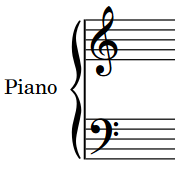Your keyboard has many punctuation marks on it, namely no less than four types of punctuation sets designed to separate words from the rest of a text. They all have multiple names as well, making them confusing to define.
These marks, called braces and brackets, include parentheses, chevrons or angle brackets, and braces. And, if you don’t know the difference between a brace and bracket, you might become frustrated when each is acceptable to use.
Let’s look at what a curly brace is and see why it is rarely used, as well as how it can be used should the opportunity present itself.
What is a Curly Brace?

Known as a brace, curly brace, or curly bracket, the {} punctuation marks are a true brace and the only punctuation mark to use brace in any part of its name.
It is a rare mark and should never be used for formal writing unless it is part of a math equation, music cord (also called an accolade), computer programming, or for separating lists of equal items.
Although not popular, it can be used informally to replace a bracket or parentheses in writing as well.
Braces vs. Brackets
There are four different types of brackets, but only one goes by the name of brace. Braces or brackets and all the other names they can go by can quickly get confusing. Use this quick chart to help define which is which and how they can be used in writing.
(…)
Parenthesis Round Bracket
To enclose supplemental information in a sentence that clarifies or illustrates information.
[…]
Brackets Square Brackets
To insert corrections, clarification, explanations, or comments in quotes.
{…}
Braces Curly Braces Curly Brackets
As part of a math equation, music cord, computer programming, and separating lists of equal items. May also replace parentheses or brackets in informal writing.
<…>
Chevrons Angle Brackets
To insert asides, mention a website, or indicate speech in a foreign language.
History of the Curly Brace
Curly braces were first used in the 1960s as part of the computer programming language BCPL. It was used as the primary symbol to block coded information together when writing a program.
Prior to its invention, brackets and parentheses were used, but these quickly became confused due to the amount of information used in writing lines of commands. Introducing a new punctuation mark helped simplify and define different lines of data.
How to Use Curly Braces in Writing
As mentioned above, curly braces should only be used in informal writing or computer programming, math, and music. Let’s look at a few examples:
Computer Programming: to block code or donate source code
{
for( int i=0; i<10; i++ )
{
System.out.print(“flag is true”);
}
Math: to denote the fractional part of a real number
{3/2} = 0.5
Music: to connect two or more lines of music
Or
The chords [{c, e, g} {e, g, c} {c, e, g}] were played over and over to help with fingering practice.
Lists: to connect lists or equal items in a sequence
I stopped by the store to pick up sandwich ingredients {gouda cheese, smoked ham, turkey, lettuce, tomatoes, onions}.
Informal Informational Offsets: to replace parentheses or square brackets
There was no way I was going on a road trip {unless the gas was paid for} since I would rather fly to my destination.
Let’s Review
Braces, a type of bracket, is also known as a curly brace or curly bracket and is rarely used in writing. It’s used as an extra punctuation mark for writing computer code and can also be seen in mathematical applications and music. In writing, you may also use it informally to replace parentheses or square brackets.

